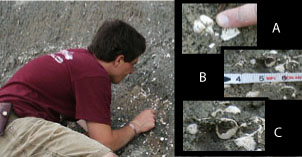Collecting Samples
Once a bed has been identified from which you wish to extract fossils,
the stratigraphic position, or height of the layer in the outcrop, is
noted. In order to collect representative samples
three features need to be noted at each
sampling location; A) Are the shells whole, not broken or jumbled, indicating little to no transport after death? B) Are the shells in "life position"
resting on the bedding planes, which also indicates no post-death movement?, C) Is
the shell size diverse, indicating a wide range of ages of
organisms, ensuring that your sample contains juveniles and adults? A method to reduce
biased sampling should be employed, for example, a tape measure can be strung across the outcrop and
positioned by pins, which allows samples to be collected at a specified interval
across the face of the bed. Fossils removed
from the outcrop are given an ID number, placed in a bag, and packaged
for transport. Back in the laboratory final identification and
preparation is conducted before data is collected from the shells.
